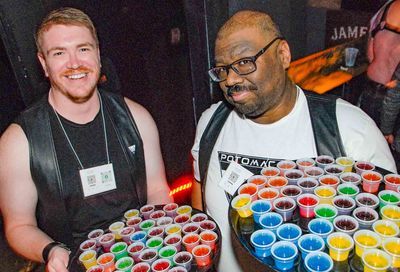“Wolfenstein: The New Order” is solid, enjoyable and decidedly retro
Wolfenstein: The New Order starts by posing one question, a question that fuels every decision and story arc over the game’s single-player narrative: What if? The series has always focused on the Nazis as an antagonist — their horrific atrocities during World War II provide endless material for inspiring gamers to pick up a gun and work through a campaign — but it does so with a heavy dose of fiction. Wolfenstein 3D, which debuted in 1992 and established most of the tropes that exist in modern first-person shooters, ended its campaign by pitting the player against Hitler, dressed in a chain-gun suit. History Channel this isn’t.
With The New Order, players once again find themselves in the shoes of protagonist William “B.J.” Blazkowicz, a U.S. soldier of Polish descent. Blazkowicz entered the series in Wolfenstein 3D and, in the time since, has killed Hitler, assassinated a variety of fictional Nazi leaders, halted Nazi weapons research, stopped plans to resurrect an ancient German king, stopped the Fourth Reich’s usage of paranormal powers to destroy their enemies, and prevented evil SS leader Deathshead from creating an army of undead cyborgs. He’s been busy, in other words.
Though he has accomplished a lot, it has all seemingly been for naught, as The New Order‘s alternate reality attempts to answer the biggest “what if” of them all: what if the Nazis had won World War II? It’s a pretty terrifying thought — Hitler and company oversaw a genocide that killed an estimated eleven million people between 1941 and 1945. What if those atrocities had been allowed to continue, unabated? In Blazkowicz’s world, it’s reality. The game opens in 1946, three years after the events of Wolfenstein, in a world where the Nazis have created advanced weaponry and transport, allowing them to easily outgun the Allied forces. Fighter jets, mechanized attack dogs, large robotic walkers — all enable the Nazis to easily swat away any Allied bombers and military units.
Players are dropped into the game in the middle of an intense firefight, as Allied forces attempt to storm a Nazi weapons research facility. Here, The New Order not only shows its age, but also proves that there’s more than a little truth to the tried-and-tested analogy. As you take control of Blazkowicz, everything feels right. He feels heavy on his feet, though far from unwieldy, moving in a way you’d expect of someone carrying so much armor and weaponry. Gun control is spot on, a nice balance between the heavy realism of Killzone and the light, zippy firearms of Call of Duty. The series that defined the first person shooter proves it can make a game feel just as good as its modern competitors.
Once you’ve expended all of the bullets in your arsenal or taken a few hits from the AI, which has been well-programmed, offering flanking maneuvers and intelligent reactions, the game’s retro roots start to show. Unlike almost every other action-oriented game on the market, and even its predecessor from 2009, Wolfenstein, there’s no health regeneration. Blazkowicz can’t endure a torrent of bullets to the chest and simply duck behind cover to feel better. Instead, Wolfenstein relies on separate health and armor meters — the latter helping dull the reduction of the former. Filling either is accomplished by finding health kits, food and pieces of armor that Blazkowicz can pick up. Ditto when that rifle you’ve been recklessly firing runs out of ammo, players will need to scour the battlefield and downed Nazis’ bodies to replenish their stocks.
At the start of the game, it feels so old-fashioned it’s almost a turn off. Picking up health and ammo is accomplished by running over it and pressing a button — it’s not automatically grabbed like in other games — which can lead to some very inelegant moments of running through areas mashing the appropriate button in the hopes that you’ll grab everything you need. However, after a while, it starts to make sense, not only because it’s the way it was handled in the original Wolfenstein 3D. Though realism is far from The New Order‘s intention, it does add a challenge to gameplay and makes Blazkowicz feel much more human and vulnerable than he otherwise would. Micromanaging his health and armor, making every bullet count, making liberal use of the simple, one-button cover system becomes an essential part of gameplay. Unlike other shooters where it’s easy to run into an open area and start firing off shots before retreating to recover and regaining any lost health, I had to really think my way around some of the trickier areas present in the campaign. Often, my own mistakes would lead to impassable situations — at one point I was left with very little health and faced with having to fight through a corridor filled with soldiers eagerly waiting to put holes in my body. Unable to advance, I had to scour the battlefield for a health kit that offered enough of a boost to ensure I’d survive the assault. Wolfenstein forced me to take care of Blazkowicz, which only helped with regard to the main highlight of playing through The New Order — its excellent narrative.
Unlike many modern shooters, where the story is present to drive you from one set piece to the other, doling out explosions and “dramatic” moments along the way, Wolfenstein‘s biggest strength is the story it successfully weaves. What helps the most this time around is that Blazkowicz is a fully realized character. His humanity is made apparent in cutscenes and internal monologues, offering a man who is battle-hardened, yes, but who also dreams of an end to the war, of settling down and having children, of living an easier life. MachineGames, who crafted the game, isn’t afraid to test his emotional limits, either. The game’s opening scene tasks the player with choosing between two characters — one will live and one will die, affecting the plot — and it’s Blazkowicz who bears the emotional impact. What’s more, shortly after, he is knocked unconscious, a piece of shrapnel embedded in his brain. Taken to an asylum in Poland, he is left to recover — for fourteen years. Yes, the main portion of Wolfenstein: The New Order takes place in 1960, and that’s what makes it all so utterly gripping.
Blazkowicz wakes up to a world unrecognizable from the one he was last conscious in. The Nazis, dominant after World War II, are a global power, their technological prowess unsurpassable. They were the first to develop the atomic bomb, which they used to force America to surrender. They conquered Europe, Asia, Africa and the Americas. They’ve embarked on space exploration, colonizing the moon. Cities levelled as the Nazis invaded have been rebuilt with concrete mega-structures — London, which features heavily in the story, is unrecognizable. Every citizen is under constant surveillance, with German citizens living in relative peace and comfort and every other race and nationality subject to routine invasions of privacy. Anyone attempting to push back against the Nazi regime is put to death or shipped to concentration camps. Blazkowicz, who has seen and done so much to halt the advance of the Nazis, who has sacrificed and killed and made horrific decisions, is forced to see that it was all for nothing.
It’s completely, utterly engrossing. I found myself drawn into the alternate reality of the game’s world, desiring to see and learn as much as possible about a possible timeline where the Nazis are victorious. The game’s history is drip-fed through newspaper clippings, personal diaries and conversations with other characters, revealing the struggles of the resistance efforts, the advance of the Nazis across the globe and the eventual change in reporting as newspapers in conquered regions are commandeered to advocate the superior Nazi way of life. The campaign sees Blazkowicz united with an underground resistance effort determined to take down the Nazi regime and it offers numerous standout moments. As the story jumps around, I found myself tasked with stealing a U-boat, infiltrating an enemy castle (stealth gameplay is executed brilliantly), boarding a train dangling from a destroyed portion of a gargantuan bridge running between Gibraltar and Africa and even walking across the surface of the moon. One standout mission saw Blazkowicz sent into a concentration camp to free a prisoner — a particularly dark moment in a campaign that has no shortage of pain and suffering. Standing inside the camp, watching as distant chimneys belched smoke into the night, hearing those enslaved wonder where their relatives and friends, whom they were separated from, were was affecting, to say the least.
Though Blazkowicz is now a defined character, he’s not the only one — The New Order features an excellent supporting cast. The resistance effort is stocked with characters from various parts of Wolfenstein’s fictional world — some returning from prior games, others brand new. All are fully realized and well-acted, with Blazkowicz’s interactions with them offering a deeper understanding of the human cost of the war effort — each has their own reason for wanting the Nazis destroyed, and these layers add up to a satisfying, ragtag group of survivors. Quiet moments between some of the more action-packed missions task Blazkowicz with walking around the resistance headquarters, assisting them with menial tasks. It’s a welcome reprieve from the intense story, letting the characters and narrative take a few breaths before throwing the player into the next chapter.
On the Nazi side of things, Deathshead offers a satisfying main antagonist, his robotic creations hounding (sometimes literally, in the case of the Panzerhunds) Blazkowicz throughout the campaign. Frau Engel fills the role of antagonist in the sections without Deathshead, first meeting Blazkowicz on a train to Berlin, and later cropping up at the concentration camp. She is a cold, calculating woman, who claims to have done her part for furthering the German master race by producing six Aryan children — indeed, she comments on rather ironic fact that Blazkowicz is a perfect example of the Nazis’ ideal physical attributes: incredibly handsome, physically fit, blonde haired and blue-eyed. She also gives a rather scary face to the dogged determination of the regime to exterminate or control every undesirable member of society.
That face, like the rest of the game is nicely animated. Many cutscenes are pre-rendered, and look great, with excellent direction, while those that use the in-game engine showcase some nice texture detail and character modelling. Overall, Wolfenstein: The New Order is an attractive game — it won’t blow you away, but it manages to convey its environments well, offering appropriate scale to the Nazis’ grand engineering works and throwing some interesting conceptual designs for what 1960s Nazi design would look like. The same is true for the sound, with gunfire, Nazi soldiers, voice acting and environmental sounds combining to drop players fully into this alternate vision of history — even down to little touches like Nazi-inspired propaganda rock ‘n’ roll and pop songs, which can be found throughout the game, offering a fascist slant on the culture propagated by America in reality.
Ultimately, however, Wolfenstein: The New Order is simply great fun to play. There’s nothing revolutionary here, nothing that other games can take inspiration from and use to advance the genre, but what The New Order does, it does very well. The highlight is the game’s narrative, which sucks you in and holds you, riveted, until the dramatic, cliffhanger ending, but the gameplay that binds it all together is solid, enjoyable, even if it is decidedly retro. What’s more, there’s very little distraction. Replay-ability is handled with five difficulty levels, two possible storylines (though both end in similar ways) and a multitude of collectibles to find in every level. However, unlike its peers, there’s no multiplayer. MachineGames wanted to focus exclusively on a well-crafted single player game, which is precisely what they’ve achieved, but Wolfenstein will ultimately suffer as a long-term purchase because of it. Regardless of that, it’s still worth your time. If you’ve exhausted every game you own and are desperately waiting for the summer drought to be over and the glut of fall releases to arrive, fire up your respective console or PC and jump into Wolfenstein‘s world, experience its alternate reality — even if it’s just to answer that most burning of questions: What if?
Support Metro Weekly’s Journalism
These are challenging times for news organizations. And yet it’s crucial we stay active and provide vital resources and information to both our local readers and the world. So won’t you please take a moment and consider supporting Metro Weekly with a membership? For as little as $5 a month, you can help ensure Metro Weekly magazine and MetroWeekly.com remain free, viable resources as we provide the best, most diverse, culturally-resonant LGBTQ coverage in both the D.C. region and around the world. Memberships come with exclusive perks and discounts, your own personal digital delivery of each week’s magazine (and an archive), access to our Member's Lounge when it launches this fall, and exclusive members-only items like Metro Weekly Membership Mugs and Tote Bags! Check out all our membership levels here and please join us today!

























